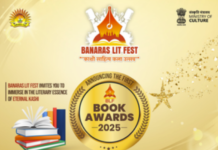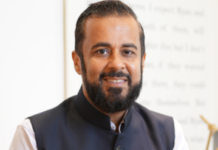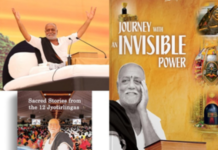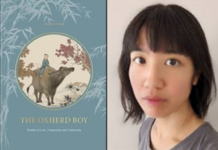By Vishnu Makhijani
New Delhi– Sports Minister Kiren Rijiju has been repeatedly stressing on the need for sportspersons to stay fit and competitive.
Rijiju reiterated his belief on Thursday, saying: “At a time like this, staying fit and building immunity is of utmost importance for everyone. The Fit India Movement envisioned by our Honourable Prime Minister and launched in August 2019, has contributed greatly in creating awareness among the masses to take up fitness as a way of life, especially during the pandemic.”
The key to this lies in the mind, writes Shayamal Vallabhjee in “Breathe, Believe, Balance – A Guide to Self-discovery and Healing” (Pan) that is aimed at both high performance sportspersons and individuals looking to lead a healthier and more fulfilling life. And, to make it easier, Vallabhjee — a South African sports scientist with a Masters in Psychology — includes “9 Realizations” as a step-by-step approach to achieving your goals.
In 2003, Vallabhjee was hired to work with the Indian team at the Cricket World Cup in his native South Africa as its technical analyst, responsible for studying the opposition, analyzing pitch conditions, and mapping data points that showed trends in performance. India made it to the finals but lost to Australia. He then trained the Indian tennis team that was preparing for the 2008 Beijing. He spent six years on the ATP Tour with professional tennis players and after the 2012 London Olympics, set up a business in India that grew to be a multi-million dollar brick and mortar physiotherapy and physical rehabilitation business.
There is no single reason why some athletes become superhumans, or for that matter, why the average individual also cannot become so, Vallabhjee points out.
“It is an intricate, dynamic balance between multiple domains that allows a chosen few to rise to the pinnacle of their potential. My thirst for knowledge sent me down the rabbit hole in search of the ideal balance. I did not find a single secret or formula. Instead, I was able to identify three broad principles that we must keep in mind during this journey,” Vallabhjee writes.
What is this magic trio?
It’s the importance of mindfulness in balance, an appreciation of the fluidity of dynamic balance, and the essential role of the fulcrum (point of support) in achieving the balance.
“With these three principles as our north star, we can all find the balance that works best for us,” the author states.
Yoga is often called the art of balance, which shows in a trained yogi’s fluid and graceful movements.
“Conversely, imbalance often brings with it a feeling of great difficulty � a lack of ease. We may feel like we are slogging our way through mud: physically, mentally, or spiritually. Nothing seems to come easy. Even the smallest of things exhaust us. Ease and effort are often the most reliable indicators of the presence or absence of balance,” the book states.
Thus, a recurring theme of the book is the importance of taking personal inventory: of our thoughts and emotions, of our body, of our relationships, and of the many dimensions of our lives.
“Imbalance can manifest subtly at first in our minds and then in our bodies. One of the reasons to practise mindfulness is that it allows us to be more alert to these subtle signs. When properly fine-tuned, both our minds and bodies are marvellous instruments. With mindfulness we can see the early signs of imbalance and take corrective steps,” the author points out.
Of major significance is the ability to be emotionally mindful.
“When we are aware of our own thoughts and feelings, and those of others, we are better equipped to make clear and grounded decisions about the words we speak and the actions we take. This quality of emotional intelligence is increasingly being recognized in the business world and elsewhere as a key factor in performance, success, and happiness. Mindfulness enables emotional intelligence; in turn, emotional intelligence allows us to live mindfully,” the book states.
How does one go about translating this into practice?
Vallabhjee explains the technique through eight chapters: Self-Love, Circles of
Connection, Start with Your Strengths, Playing with Perspective, Freeing Yourself from Destructive Patterns, Engineering Your Environment, Being Mindful in Communication and Conflict, and Self-transcendence and the Power of Purpose.
The pursuit of balance that he advocates, the author points out, is a never-ending process.
“If an athlete was to hold off competing until they felt perfectly in control of the necessary knowledge and experience, and of their mental and physical states, they probably would never compete. We prepare as adequately as we can, and then we trust our process and accept the outcome. Similarly, part of an artist’s journey is to find the courage to leave their mark on the world and then accept whatever reverence and criticism it brings,” Vallabhjee writes.
In conclusion, what are the “9 Realizations” that the book offers as a guide to living a more fulfilling life?
These are: You cannot heal that which you do not understand, You cannot fix that which you are not prepared to change, You cannot love yourself if you hate the experiences that have made you the person you are, Everything you attract in your life is based on your own vibrational energy, You have to see yourself as a co-creator of your destiny, Your willingness to change what is working could become your greatest strength, To change your current reality, you have to make the unfamiliar familiar, You cannot heal yourself in the same environment that caused you pain, You cannot evolve if you fear the process of growth.
In simple terms, just go for it! (IANS)















